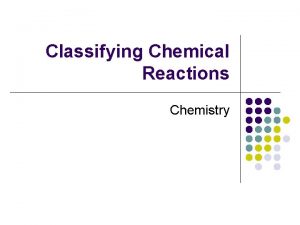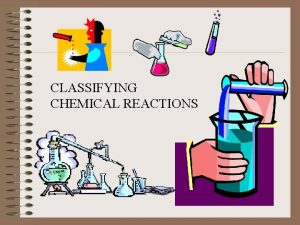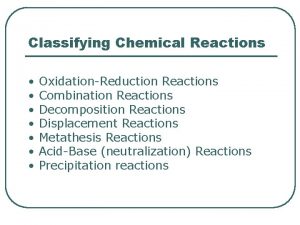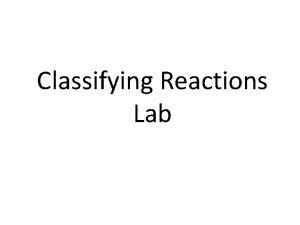Chapter 19 Chemical Reactions Section 2 Classifying Chemical









- Slides: 9

Chapter 19: Chemical Reactions Section 2: Classifying Chemical Reactions

Vocabulary Review New • states of matter • • Copyright © Mc. Graw-Hill Education combustion reaction synthesis reaction decomposition reaction single-displacement reaction double-displacement reaction precipitate oxidation reduction Classifying Chemical Reactions

Types of Reactions • Chemists have defined five main categories of chemical reactions: • combustion • synthesis • decomposition • single displacement • double displacement Classifying Chemical Reactions

Combustion reactions • A combustion reaction occurs when a substance reacts with oxygen to produce energy in the form of heat and light. • Many combustion reactions also fit into other categories of reactions. Classifying Chemical Reactions

Synthesis reactions • In a synthesis reaction, two or more substances combine to form another substance. • The generalized formula for this reaction type is as follows: A + B AB Classifying Chemical Reactions

Decomposition reactions • A decomposition reaction occurs when one substance breaks down, or decomposes, into two or more substances. • Reverse of a synthesis reaction • The general formula for this type of reaction type is: AB A + B • Most decomposition reactions require the use of heat, light, or electricity. Classifying Chemical Reactions

Single displacement • When one element replaces another element in a compound, it is called a single-displacement reaction. • Single-displacement reactions are described by the general equation A + BC AC + B • We can predict which metal will replace another by comparing how reactive they are. • A metal will replace any less active metal. Classifying Chemical Reactions

Double displacement • In a double-displacement reaction, the positive ion of one compound replaces the positive ion of the other to form two new compounds. • The generalized formula for this type of reaction is as follows: AB + CD AD + CB • A double displacement reaction results in a precipitate, water, or a gas forming when the two ionic compounds are combined. • A precipitate is an insoluble compound that comes out of solution. Classifying Chemical Reactions

Oxidation – Reduction Reactions • One characteristic that is common to many chemical reactions is the tendency of the substances to lose or gain electrons. • Oxidation: the loss of electrons • Reduction: the gain of electrons • The substance that loses an electron or electrons then becomes more positive, and we say it is oxidized. • The substance that gains an electron or electrons obviously becomes more negative, so we say it is reduced. • Oxidation and reduction are partners, and often referred to as redox. Classifying Chemical Reactions
 Section 2 classifying chemical reactions worksheet answers
Section 2 classifying chemical reactions worksheet answers Section 2 reinforcement classifying chemical reactions
Section 2 reinforcement classifying chemical reactions Types of reactions
Types of reactions Chemical reactions section 1 chemical changes
Chemical reactions section 1 chemical changes Chapter 18 chemical reactions balancing chemical equations
Chapter 18 chemical reactions balancing chemical equations Chapter 8 review chemical equations and reactions
Chapter 8 review chemical equations and reactions Chapter 8 section 1 chemical equations and reactions
Chapter 8 section 1 chemical equations and reactions Chapter 10 chemical reactions
Chapter 10 chemical reactions Chapter 9 chemical reactions
Chapter 9 chemical reactions Combination reaction equation
Combination reaction equation

















